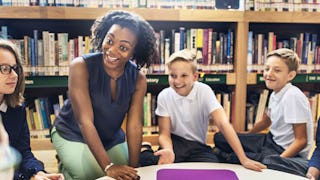The Foundations of Teaching for Learning programme is for anyone who is teaching, or who would like to teach, in any subject and any context - be it at school, at home or in the workplace. With dynamic lessons taught by established and respected professionals from across the Commonwealth, this eight course programme will see you develop and strengthen your skills in teaching, professionalism, assessment, and more. As you carry on through the programme, you will find yourself strengthening not only your skills, but your connection with colleagues across the globe. A professional development opportunity not to be missed.

Enjoy unlimited growth with a year of Coursera Plus for $199 (regularly $399). Save now.

Foundations of Teaching for Learning: Being a Teacher


Instructors: Professor Dennis Francis
95,538 already enrolled
Included with
(1,097 reviews)
Skills you'll gain
Details to know

Add to your LinkedIn profile
See how employees at top companies are mastering in-demand skills

There are 6 modules in this course
The first week of this course looks at what it means to be a teacher. We look at the many roles that a teacher plays and why each of these is important. We consider what it means to be an effective teacher. We look at ways in which we can improve what we do as teachers using a model of continuous professional development. Finally, we consider what a philosophy of education is and how we can develop a philosophy that guides our teaching.
What's included
5 videos5 readings1 assignment
The second week of this course looks at teachers’ sense of identity, and the differing reasons and motivations people have for becoming a teacher. We ask you to consider the influences on you and particularly the people who may have played a part in your decision to join the profession. You will reflect on the nature of transactions in the classroom and the differing ways in which students respond to how teachers address them. The fourth lecture draws on educational theorist Jacob Kounin’s key strategies that expert teachers to manage classrooms effectively.
What's included
5 videos1 reading1 assignment1 peer review
The third week of this course continues the theme of how your teaching and learning has been influenced by other key people or events. You will learn about the primary motivations that persuade people to take up teaching as a career. How do you communicate with children, or adult learners, in ways that helps them to grasp key concepts and ways of thinking? Reflecting on your teaching and on your students’ learning may help you to have a greater impact as a teacher. The fourth lecture, entitled Asking or Telling address fundamental issues of pedagogy, reminding us that ‘telling’ is rarely an effective strategy for teaching either as a teacher or a parent, whereas questioning requires activity and involvement on the part of the learner.
What's included
4 videos1 reading1 assignment
This week we look at the impact our social identities have on our learning. The four lectures in week four are all related to the theme of difference. It will be important for you to think about your own socialization and how you learned about difference. Is difference something you learned to value or is it something you have learned to ridicule? Think about how you deal with difference in your personal context and in your classroom. We encourage you to write a narrative in which you bring together a reflection on your own socialization and how this impacts on your teaching.
What's included
5 videos1 reading1 assignment1 peer review
How do I learn best? During this week we will focus on how you learn best and how you can make the connections with your own classroom and learners. We encourage you to think more about how we learn as teachers, and how we can create the best conditions for ourselves and our students to learn.
What's included
4 videos1 reading1 assignment
Congratulations, you have stayed throughout the course 'Being a teacher'. I hope you have been making the connection between how you have learned and how you teach. During this week we will focus on 'My learning environment'. We will explore the principles of pedagogy, specifically Alexander’s nine aspects of pedagogy. In the fourth and final lecture, we also revisit some of the key ideas explored on the course.
What's included
5 videos1 reading1 assignment
Instructors


Offered by
Explore more from Education

Commonwealth Education Trust

Commonwealth Education Trust

Commonwealth Education Trust

Commonwealth Education Trust
Why people choose Coursera for their career




Learner reviews
1,097 reviews
- 5 stars
76.29%
- 4 stars
17.22%
- 3 stars
3.28%
- 2 stars
1.54%
- 1 star
1.64%
Showing 3 of 1097
Reviewed on Sep 15, 2022
I had a great time taking this course with DR. Dennis Francis. Learned so many new things, and how to improve my teaching skills. Hats off for him!
Reviewed on Aug 15, 2020
Amazing course for teachers. It helped me a lot in understanding more about being a teacher and how I can grow and develop, understand my students and classroom.
Reviewed on Jun 16, 2025
Overall, the course was a crucial step in my professional development. It helped me evolve from being just a teacher to becoming a thoughtful and reflective educator.

Open new doors with Coursera Plus
Unlimited access to 10,000+ world-class courses, hands-on projects, and job-ready certificate programs - all included in your subscription
Advance your career with an online degree
Earn a degree from world-class universities - 100% online
Join over 3,400 global companies that choose Coursera for Business
Upskill your employees to excel in the digital economy
Frequently asked questions
To access the course materials, assignments and to earn a Certificate, you will need to purchase the Certificate experience when you enroll in a course. You can try a Free Trial instead, or apply for Financial Aid. The course may offer 'Full Course, No Certificate' instead. This option lets you see all course materials, submit required assessments, and get a final grade. This also means that you will not be able to purchase a Certificate experience.
When you enroll in the course, you get access to all of the courses in the Specialization, and you earn a certificate when you complete the work. Your electronic Certificate will be added to your Accomplishments page - from there, you can print your Certificate or add it to your LinkedIn profile.
Yes. In select learning programs, you can apply for financial aid or a scholarship if you can’t afford the enrollment fee. If fin aid or scholarship is available for your learning program selection, you’ll find a link to apply on the description page.
More questions
Financial aid available,
¹ Some assignments in this course are AI-graded. For these assignments, your data will be used in accordance with Coursera's Privacy Notice.

